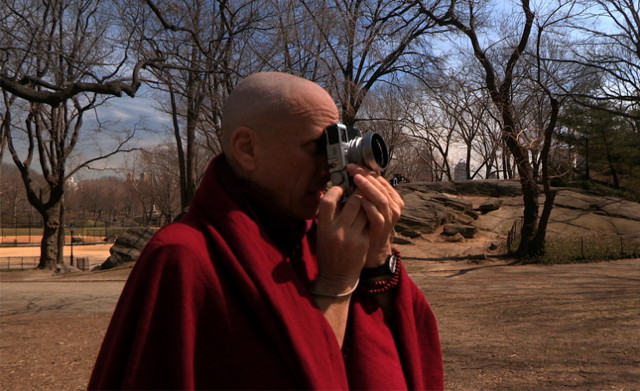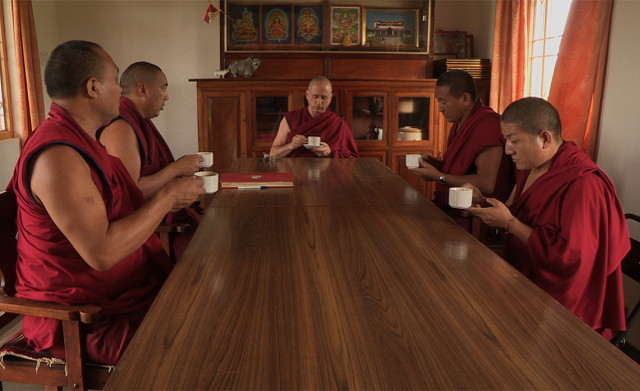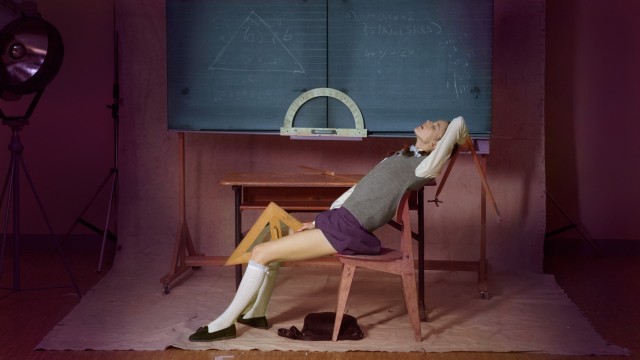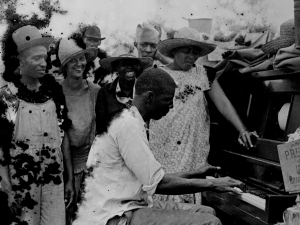There’s no way we can ever stop loving a crazy live band that celebrates “drinking, smoking weed & all types of ill shit,” so we have a fondness for local hip-hop funk rockers Shinobi Ninja, who also have a song called “Rusty Stab” and a video-game EP titled Shinobi Ninja Attacks! Over the last few weeks, we’ve been following their road trip as they travel around making new music with a Monster Go DJ portable unit and seek to escape from New York. On November 22, Duke Sims, Baby G, Maniak Mike, Alien Lex, Axis Powers, and Terminator Dave will be at Cameo Gallery in Brooklyn for the Monster Van Album Release Party, joined by Sunshine Gun Club, Cowboys 2 Girls, and City of the Sun. On “What If Times,” Shinobi Ninja asks, “What if times don’t get no better than this?” With Shinobi Ninja, times always get better. The gang will also be back in town on December 28 for a big show with Fishbone and Nonstop to Cairo at the Gramercy.
twi-ny recommended events
MONK WITH A CAMERA
MONK WITH A CAMERA (Tina Mascara & Guido Santi, 2014)
Film Society of Lincoln Center, Walter Reade Theater / Howard Gilman Theater
144/165 West 65th St. between Eighth Ave. & Broadway
November 21-27
212-875-5050
www.filmlinc.com
www.monkwithacamera.com

In 1977, Nicholas “Nicky” Vreeland, the playboy grandson of fashion legend Diana Vreeland and the son of U.S. ambassador Frederick “Frecky” Vreeland, began studying Buddhism with Khylongla Rinpoche. He eventually moved to India, became a monk, and led the rebuilding of the Rato Monastery. He shares his life story in the curious, deeply engaging documentary Monk with a Camera. “I don’t know what led me to wish to pursue a spiritual path,” he says early on, dressed in his red Tibetan monk’s robes. “Was I unhappy? No more unhappy than anyone else. I did feel that there was a way, a life outside the sort of normal life. I had some kind of belief that there was something beyond material satisfaction and things like that.” Born into privilege and living life to the fullest, he was a talented amateur photographer experiencing carnal pleasures, speeding down the Champs-Élysées, and using his connections to work with such photographers as Irving Penn and Richard Avedon, But he gave it all up, eventually moving to India to undertake a more philosophical, self-reflective, and celibate existence — in the film he playfully refers to one of his cameras as his girlfriend. Vreeland fell in love with photography at a young age, and he struggles with the attachment he still has with the medium, understanding that it might be a worldly indulgence that goes against his renunciation of earthly delights. But it turns out that his photography ends up playing a major role in the expansion of Rato Monastery.
Directors Tina Mascara and Guido Santi, who previously collaborated on Chris & Don: A Love Story, maintain a calm, meditative pace throughout Monk with a Camera, matching Vreeland’s calm, meditative demeanor. Vreeland, resembling a bald, older Steve Carell, walks and talks in carefully measured tones, adding bits of sly humor with his naturally infectious smile. Among those sharing insight into his life are his brother, Alexander Vreeland, who urged him to keep taking photos even after becoming a monk; his stepbrother, writer Ptolemy Tompkins; writer John Avedon, keeper of the Richard Avedon archives; photographer Priscilla Rattazzi; New York magazine design editor Wendy Goodman; his longtime friend and fellow Buddhist, Richard Gere; and his father, who says, “What it was that drove him to spirituality? I’m a person who doesn’t believe that there’s ever one cause for any effect, that there were multiple causes,” before telling a wonderful anecdote about Nicky’s first visit to Dharamsala. The film also includes playful comic-book-style animation by Joe Rothenberg and a lovely scene in which Nicky, Khylongla Rinpoche, and Richard Gere meet with His Holiness the 14th Dalai Lama, who chuckles as he delivers some seriously funny lines. Monk with a Camera is a lovingly told story about one man’s unique relationship with the world, a tale that will have audiences considering their own relationship with such central Buddhist ideals as attachment and impermanence. Monk with a Camera begins a one-week run November 21 at the Film Society of Lincoln Center; the 7:20 screenings on Friday and Saturday will be followed by a Q&A with producers, editors, and directors Mascara and Santi and subject Nicky Vreeland, and there will be a Q&A with Vreeland and Gere in the Furman Gallery after the 5:20 screening on Saturday for ticket holders only.
THE CONTENDERS 2014 — NYMPHOMANIAC: EXTENDED DIRECTOR’S CUT
NYMPHOMANIAC: EXTENDED DIRECTOR’S CUT (Lars von Trier, 2013)
MoMA Film, Museum of Modern Art
11 West 53rd St. between Fifth & Sixth Aves.
Sunday, November 23, 2:30
Series runs through January 16
Tickets: $12, in person only, may be applied to museum admission within thirty days, same-day screenings free with museum admission, available at Film and Media Desk beginning at 9:30 am
212-708-9400
www.moma.org
www.magpictures.com
When I reviewed Lars von Trier’s Nymphomaniac earlier this year, when it was released in two separate “volumes,” I wrote, “I certainly would have preferred seeing Nymphomaniac in one complete sitting rather than in two parts, one of which stands head and shoulders above the other (although they do need each other); however, I’m not sure what I’ll do when the five-and-a-half-hour director’s cut is released later this year.” Well, as promised, the extended director’s cut is now available for viewing, being shown November 23 at 2:30 as part of MoMA’s annual series “The Contenders,” consisting of films the institution believes will stand the test of time. What follows is a slightly amended version of my initial review of the first two volumes; there are an additional thirty minutes added to the first part, while the second part now includes what MoMA refers to as “some of the most gruesome and wrenching passages ever seen on film.”
In Breaking the Waves, Danish Dogme 95 cofounder Lars von Trier’s 1996 breakthrough, Stellan Skarsgård plays a paralyzed man who convinces his wife (Emily Watson) to have sexual liaisons with other men and then tell him about the encounters in graphic detail. In von Trier’s latest controversial, polarizing work, Nymphomaniac, Skarsgård stars as Seligman, a single man who takes in a woman named Joe (Charlotte Gainsbourg) who is soon sharing her own sexual adventures with him, in extremely graphic detail. After finding Joe severely beaten in an alley, Seligman nurses her back to health while carefully listening to her life story. She repeatedly says she is a bad, irredeemable human being because of the things she has done, which started to go off the rails when she was a small child discovering the pleasure sensations to be had in her nether regions. Her sordid tale is told in flashbacks, as her younger self (Barking at Trees’ Stacy Martin) goes from lover to lover to lover to lover to lover ad infinitum. (The specific numbers are plastered over the screen.) Along the way, Seligman offers his own interpretation of her life, praising her sense of freedom while comparing her sexuality to fly-fishing, which von Trier (Dancer in the Dark, Melancholia, Antichrist) relates in a playful way that is at first absurdly silly but actually ends up coming together. Unfortunately, however, Martin is far too bland as Joe as she beds victim after victim, including Jerôme (a miscast Shia LaBeouf), perhaps the only one who truly loves her. The film also features Christian Slater and Connie Nielsen as Joe’s parents and Uma Thurman as a scene-stealing wronged wife.
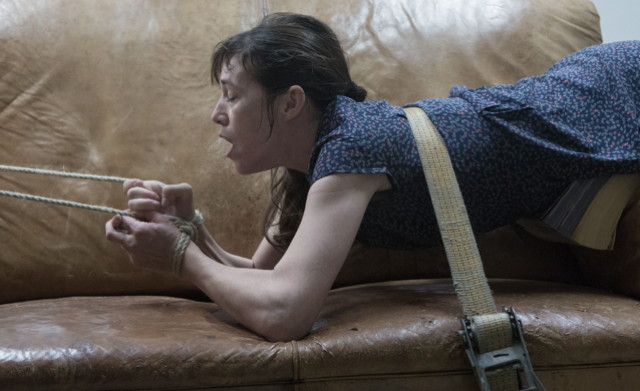
Joe (Charlotte Gainsbourg) continues her search for sexual pleasure and pain in the second half of NYMPHOMANIAC (photo by Christian Geisnaes)
The second half of von Trier’s four-hour graphic exploration of feminine sexuality and the very nature of storytelling itself is a masterfully crafted, often deadly dull and repetitive, but, in the end, gloriously inventive work. Joe (Charlotte Gainsbourg) is in the midst of telling her brutally in-depth tale of sexual addiction to the sincere and respectful Seligman (Stellan Skarsgård), who brought her into his home upon finding her badly beaten in a dark alley. In the flashbacks, Joe is now played with mystery and complexity by Gainsbourg, after the young Joe had been previously portrayed by the bland and boring Stacy Martin, and the change of actress is one of the key reasons why the second part works so much better than the first. Joe shares details of trying to make a sex sandwich, giving group therapy a shot, becoming obsessed with a violent sadist (Jamie Bell), and accepting a dangerous job with L (Willem Dafoe).
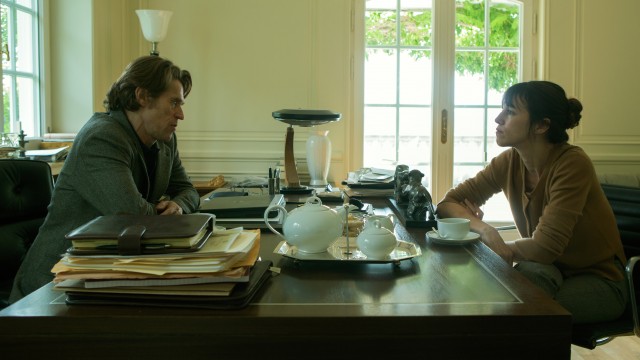
L (Willem Dafoe) offers Joe (Charlotte Gainsbourg) a dangerous job in controversial Lars von Trier sexual epic (photo by Christian Geisnaes)
In between her stories, which are divided into such chapters as “The Eastern and the Western Church (The Silent Duck)” and “The Mirror,” Seligman delves into various intellectual theories to help explain her exploits, discussing religion, paradox, democracy, language, mythology, Freud, and such dichotomies as suffering and happiness, pleasure and pain, Wagner and Beethoven, and the virgin and the whore. Cinematographer Manuel Alberto Claro’s camera is far more steady in these scenes, in contrast to the moving, handheld shots that dominate the flashbacks. The interplay between the calm, gentle Seligman and the lonely, lost Joe is beautifully acted and inherently touching, but, this being von Trier, the film’s ending will further controversies that already involve episodes of extreme violence and actual sexual penetration (the latter performed by body doubles). The MoMA series continues through January 16 with such other 2014 cinematic entries as Gillian Robespierre’s Obvious Child, Bennett Miller’s Foxcatcher, and Damien Chazelle’s Whiplash.
MONSANTO IS THE DEVIL
Joe’s Pub at the Public Theater
425 Lafayette St. at Astor Pl.
Sunday, November 23, 30, and December 7, 14, 21, $15, 2:00
212-967-7555
www.publictheater.org
www.revbilly.com
Over the past year, anti-consumerist activists Reverend Billy and the Stop Shopping Choir have been battling against corporations’ role in climate change. “The activism is content for the play,” they explain on their website, using cash register exorcisms, retail interventions, cell phone operas, live performances, and protest marches to help save the world from imminent destruction, taking inspiration from the opening scene of John Huston’s The Night of the Iguana. They’ve been fighting for Earth Justice for fifteen years, and that journey continues with their latest show, Monsanto Is the Devil, running Sunday afternoons at Joe’s Pub from November 23 through December 21, led by director Savitri D. and musical director Nehemiah Luckett and joined by the Not Buying It Band. The eco-televangelist will also be leading his minions on a march on Monsanto’s St. Louis headquarters as they enjoy an organic Thanksgiving dinner on the company’s lawn, after which they will spend Black Friday in Ferguson, Missouri. “Monsanto is a right-wing apocalyptic fundamentalist religion; all the big corporations, all the big nature-hating corporations, are. That’s something we have to understand,” Reverend Billy preaches, adding, “When you deal with Monsanto, we can’t be polite.” The reverend and his choir, which protested the state of the honeybee in The HoneyBeeLujah Show earlier this year at Joe’s Pub, are unlikely to be polite as they take on the self-described Sustainable Agriculture Company’s use of pesticides, GMO crops, and other controversial methods and dealings. The Shopocalypse continues….
PULP: A FILM ABOUT LIFE, DEATH AND SUPERMARKETS
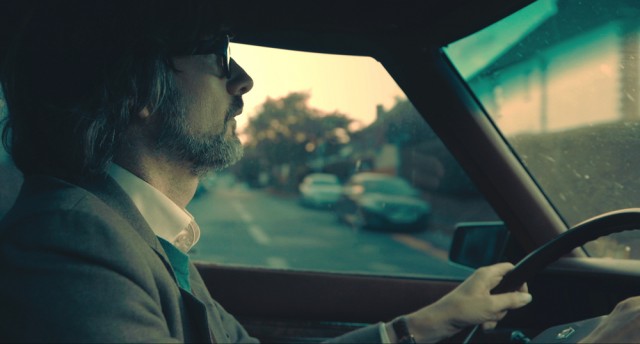
Jarvis Cocker takes a ride through his hometown of Sheffield as he prepares for Pulp farewell concert
PULP: A FILM ABOUT LIFE, DEATH & SUPERMARKETS (Florian Habicht, 2013)
IFC Center
323 Sixth Ave. at West Third St.
Opens Wednesday, November 19
212-924-7771
www.ifccenter.com
www.pulpthefilm.com
 Florian Habicht’s Pulp: A Film About Life, Death & Supermarkets is a brilliant inside look at the long-lasting relationship between a band and its hometown. In December 2012, British alternative band Pulp returned to the place of its birth, the rugged, working-class city of Sheffield in the north of England, for what was being billed as its last-ever concert on dry land. Pulp frontman Jarvis Cocker hooked up with Habicht (Love Story, Woodenhead), conceiving a project in which the time and place, along with the fans, would be just as important as the band and its music, if not more so. In the nonchronological film, Habicht cuts between archival footage of Pulp, clips from the final concert, interviews on the street with old and young fans, and brief chats with Pulp tour manager Liam Rippon and the other band members: guitarist Mark Webber, keyboardist Candida Doyle, bassist Steve Mackey, and drummer Nick Banks, who are pretty much taking it all in stride. But at the center of it all is the soft-spoken, enigmatic Cocker, who founded Pulp back in 1978 when he was fifteen years old.
Florian Habicht’s Pulp: A Film About Life, Death & Supermarkets is a brilliant inside look at the long-lasting relationship between a band and its hometown. In December 2012, British alternative band Pulp returned to the place of its birth, the rugged, working-class city of Sheffield in the north of England, for what was being billed as its last-ever concert on dry land. Pulp frontman Jarvis Cocker hooked up with Habicht (Love Story, Woodenhead), conceiving a project in which the time and place, along with the fans, would be just as important as the band and its music, if not more so. In the nonchronological film, Habicht cuts between archival footage of Pulp, clips from the final concert, interviews on the street with old and young fans, and brief chats with Pulp tour manager Liam Rippon and the other band members: guitarist Mark Webber, keyboardist Candida Doyle, bassist Steve Mackey, and drummer Nick Banks, who are pretty much taking it all in stride. But at the center of it all is the soft-spoken, enigmatic Cocker, who founded Pulp back in 1978 when he was fifteen years old.
Habicht shows Cocker biking and driving through Sheffield, discussing his first job working for a fishmonger in a mall, and, most thrillingly, fixing a flat tire on his less-than-fancy car. The theme song of the documentary is Pulp’s “Common People,” in which a woman tells Cocker, “I want to live like common people / I want to do whatever common people do / I want to sleep with common people / I want to sleep with common people like you.” Is it possible for a rock star to be “common people”? It doesn’t really matter as Cocker reestablishes his connection to Sheffield. “We stopped playing in 2001 or 2002 or whatever it was, and I did feel that the way it finished was kind of a bit, I don’t know, not right,” he says in the film. “It didn’t feel like a good ending. . . . So I know that tidying up isn’t the greatest rock-and-roll motivation, but I did want to kind of tidy things up and give the story a happy ending.” It is all very happy indeed, as Habicht also delves into such Pulp favorites as “This Is Hardcore” and “Help the Aged” as well as “Disco 2000,” “Underwear,” and “Sheffield: Sex City.” The band, which released seven studio albums during its career, from 1983’s It through 2001’s We Love Life, has no arguments or complaints, just positive attitudes that make Pulp a thoroughly exhilarating experience.
BILL MORRISON — COMPOSITIONS: BILL FRISELL, RON MILES, TONY SCHERR, AND KENNY WOLLESEN PERFORM LIVE WITH “THE GREAT FLOOD”
BILL FRISELL, RON MILES, TONY SCHERR, AND KENNY WOLLESEN PERFORM LIVE WITH THE GREAT FLOOD (Bill Morrison, 2011)
MoMA Film, Museum of Modern Art
11 West 53rd St. between Fifth & Sixth Aves.
Friday, November 21, 8:00
Tickets: $12, in person only, may be applied to museum admission within thirty days, same-day screenings free with museum admission, available at Film and Media Desk beginning at 9:30 am
212-708-9400
www.moma.org
www.icarusfilms.com
 Sound and image meld together beautifully in Bill Morrison’s meditative, elegiac The Great Flood. Inspired by John M. Barry’s 1997 book Rising Tide: The Great Mississippi Flood of 1927 and How It Changed America, Morrison teamed up with improvisational musician Bill Frisell on the project. The two had previously worked together on a pair of short works, The Mesmerist and The Film of Her, after meeting at the Village Vanguard when Morrison was a dishwasher at the jazz club where Frisell was playing. Morrison (Decasia, The Miners’ Hymns), who specializes in using deteriorated and degraded archival footage and experimental scores, scoured the National Archives, the Library of Congress, the Hoover Presidential Library, and other sources to come up with remarkable scenes of the flooding of the Mississippi in 1927. Divided into such chapters as “Sharecroppers,” “Swollen Tributaries,” “Evacuation,” “Aftermath,” and “Watershed,” with snippets of informational text but without narration, the film follows the southern blacks who were most affected by the massive flood, being forced to shore up the levees around white areas, losing their own homes, and ultimately heading north as part of the Great Migration, bringing the Delta blues with them.
Sound and image meld together beautifully in Bill Morrison’s meditative, elegiac The Great Flood. Inspired by John M. Barry’s 1997 book Rising Tide: The Great Mississippi Flood of 1927 and How It Changed America, Morrison teamed up with improvisational musician Bill Frisell on the project. The two had previously worked together on a pair of short works, The Mesmerist and The Film of Her, after meeting at the Village Vanguard when Morrison was a dishwasher at the jazz club where Frisell was playing. Morrison (Decasia, The Miners’ Hymns), who specializes in using deteriorated and degraded archival footage and experimental scores, scoured the National Archives, the Library of Congress, the Hoover Presidential Library, and other sources to come up with remarkable scenes of the flooding of the Mississippi in 1927. Divided into such chapters as “Sharecroppers,” “Swollen Tributaries,” “Evacuation,” “Aftermath,” and “Watershed,” with snippets of informational text but without narration, the film follows the southern blacks who were most affected by the massive flood, being forced to shore up the levees around white areas, losing their own homes, and ultimately heading north as part of the Great Migration, bringing the Delta blues with them.
Guitarist Frisell, joined by Ron Miles on cornet, Tony Scherr on guitar and bass, and Kenny Wollesen on drums and vibes, has composed a gorgeous, moving score, heavily influenced by a trip his band and Morrison took in early 2011 up the Mississippi, with the group playing in multiple cities while the river threatened to flood again. Each chapter, from an overhead view of a computerized map that details the 1927 flood to a fast and furious foray through the Sears Roebuck catalog, from a Baptist church procession to a series of rare clips of such bluesmen as Big Bill Broonzy, Son House, Sonny Boy Williamson, and Robert Lockwood, features a different piece of music, highlighted by Frisell’s always inventive guitar and Miles’s deeply expressive horn. Of course, as the images pass by, it’s impossible not to think of Hurricanes Katrina and Sandy and be awed by the devastating power of nature, as well as realize how little has changed with regard to the reaction of politicians and who the victims tend to be. But the film is rarely mournful; instead, there’s often a celebratory quality about it, centered on people’s natural instinct to survive. The Great Flood is screening November 21 at 8:00, concluding MoMA’s “Bill Morrison: Compositions,” with Frisell, Miles, Scherr, and Wollesen performing the score live as a special treat. In addition, MoMA’s rotating “Bill Morrison: Re-Compositions” exhibition currently features “Decomposing Loops,” consisting of excerpts from Light Is Calling, Just Ancient Loops, and Decasia, through December 8.
VIDEO OF THE DAY: “SHE GUTTA” BY MYKKI BLANCO
This is not your bubby’s Jewish Museum. On November 20, the latest edition of the Upper East Side institution’s “The Wind Up” features Mykki Blanco, the cross-gender rapper, poet, and performance artist also known as Michael David Quattlebaum Jr. As Quattlebaum, he has written From the Silence of Duchamp to the Noise of Boys, a compilation of twenty-three poems including “The Intimacy of Being,” “Freak Jerk,” “Black Boys Are Flowers Too,” and “I Am Young Please Forgive Me,” several of which have been turned into songs by her band, Mykki Blanco & the Mutant Angels, which has released such albums as Betty Rubble: The Initiation and the three-track EP Spring/Summer 2014. In “Poem I” he writes, “I am not a man of reason / And that is exact / I am precisely not a man of logic / And that is inarguable / At some point my soul left me / It was all very casual, you know, in / that way things can sometimes be / It grew tired of my body, I suppose.” Blanco will appear in Scheuer Auditorium along with DJ P. Morris in conjunction with the Abstract Expressionist exhibition “From the Margins: Lee Krasner and Norman Lewis, 1945–1952”; the evening will also include spin art T-shirt making, a painting station, a beer and wine bar, and exhibition tours.
